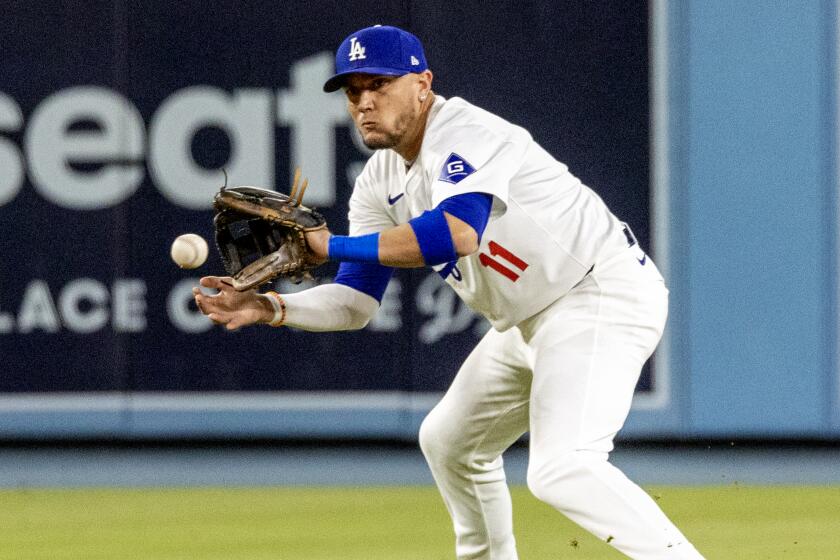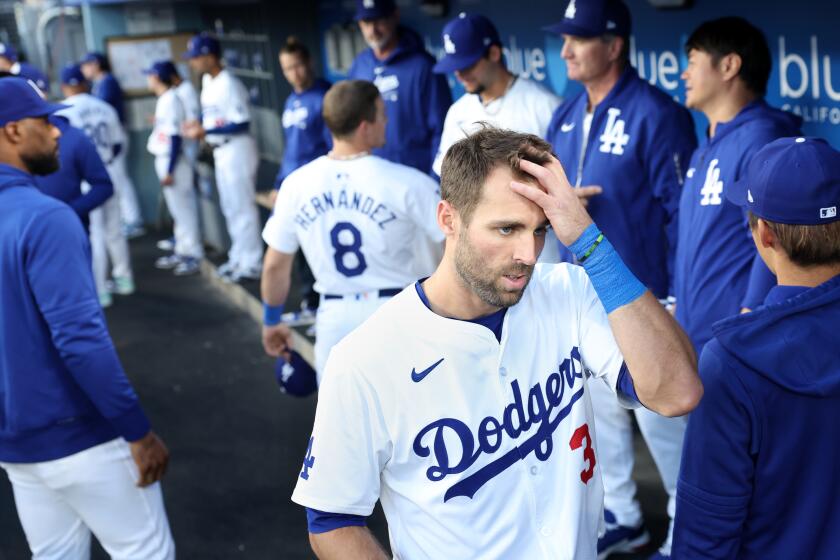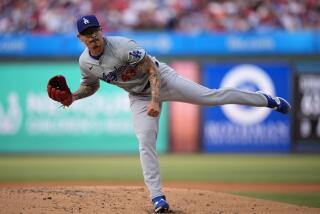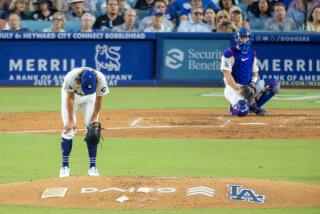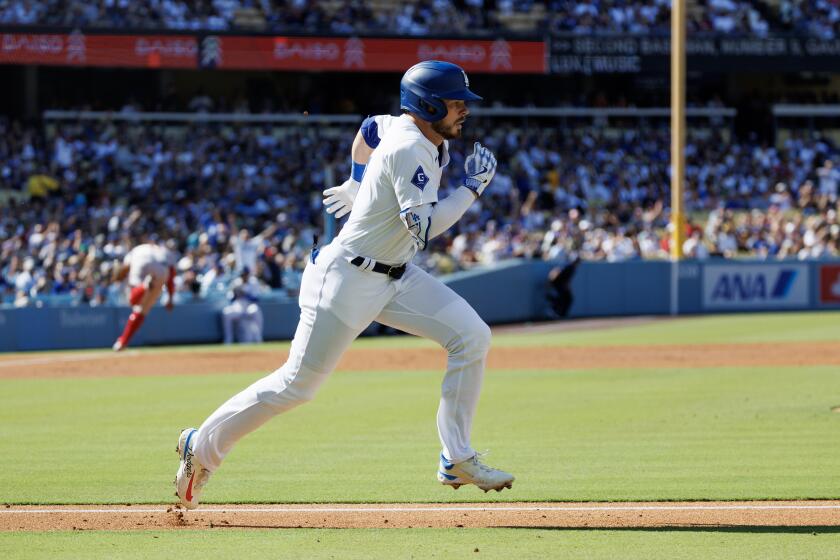News Analysis: ‘We need them.’ Why it’s crucial for Dodgers to find ‘spark’ from bottom half of lineup

It was a postseason flashback, in all the worst ways.
The Dodgers’ superstar hitters weren’t at their best. The lineup’s supporting cast offered little actual support. And, suddenly, a high-priced offense expected to fuel a World Series pursuit instead flashed potential weaknesses that have been exploited in past Octobers.
“It felt a lot like last year’s playoffs,” infielder Miguel Rojas said, “when we couldn’t get it going.”
Rojas was referring to the team’s recent offensive slump, a two-week malaise in which the Dodgers averaged just 3.5 runs per game while losing nine of 16 and five in a row — their longest losing streak in the last five years.
It may be no more than a brief slump that ended with this week’s three-game sweep of the New York Mets.
Miguel Rojas has been a valuable utility man this season. But there are no advanced metrics to quantify the impact and influence Rojas has had on fellow infielders.
They’re still in first place in the National League West.
They’re still a near lock to make the playoffs.
They’re still among the top three teams in scoring, batting average and on-base-plus-slugging percentage, thanks to superstars Shohei Ohtani, Mookie Betts and Freddie Freeman.
Yet, as Rojas noted pointedly, the skid brought back memories of last year’s National League Division Series against the Arizona Diamondbacks, when the offense disappeared in a three-game sweep.
“We can’t just rely on Shohei [hitting a] homer, Freddie [hitting a] homer, Mookie being on a tear,” Rojas said. “We have to find a way to do it with small ball too. The small ways of playing the game. On defense. Running the bases.”
And, as the first two months have exemplified, getting more production out of the bottom half of the lineup.
To this point, the Dodgers couldn’t have asked for much more from their top-of-the-order bats — a group including Betts, Ohtani, Freeman, Will Smith and, depending on the opposing pitcher, either Teoscar Hernández or Max Muncy.

From the top five spots in the lineup, the Dodgers are a distant first in batting average (.299, 18 points better than any other team) and OPS (.902, 87 points better). They are second in RBIs (185) and third in home runs (52). They have the best walk-to-strikeout ratio. They are a headache to pitch against every time the lineup turns over.
Get past the first five spots hitters, though, and the firepower starts to cease.
On any given night, the Nos. 6 through 9 spots in the order will be occupied by a combination of Kiké Hernández, Gavin Lux, Andy Pages, Jason Heyward, Chris Taylor, Austin Barnes and Rojas.
The hope was for that group to provide enough positional versatility, platoon advantages and timely offense to buttress the star-studded core the Dodgers built around. Instead, they’ve performed like one of the weakest offensive units in the majors.
Chris Taylor spent his offseason focused on what made his swing so effective. A quarter of the way through the season, he’s having a career-worst year.
The Dodgers’ 6-9 hitters have batted a collective .200, fourth worst in MLB. Their .586 OPS ranks only one spot better. They strike out a lot (26%, 10th highest). They rarely walk (7%, 10th lowest). And outside of Rojas (batting .284 with a .790 OPS), no one is providing consistent offense.
There are top-heavy lineups. And then there are this year’s Dodgers.
The recent 16-game lull illustrated the consequences of such shortcomings. During the stretch, the Dodgers’ top half slipped out of top gear. Betts and Ohtani cooled off slightly. Freeman and Smith battled mini-slumps. Muncy was sidelined because of an oblique strain.
The bigger problem, though, was that the bottom half provided virtually no production. The 6-9 hitters batted .187. At one point during the losing streak, they were a combined 0 for 34, going almost three games without a hit.
As a result, the offense came screeching to a halt; the Dodgers scored more than four runs in just six of the 16 games. Troubles that had doomed them in last year’s playoffs, and at times the two postseasons before that, were abounding again.
“We need them,” manager Dave Roberts said last week of the bottom half. “I just don’t want to pin it on those guys down there. But we’re trying to find somebody that’s gonna spark us.”
That’s why, as the July 30 trade deadline creeps into focus, the Dodgers’ most basic need is clear.
Either their current cast of bottom-half hitters finds some sort of breakthrough. Or the Dodgers likely will have no choice but to seek an impact bat or two, potentially requiring further roster reinforcements even after their $1.4 billion of spending over the offseason.
“I do think those guys at the bottom, outside of probably Miguel Rojas, are just underperforming,” Roberts said. “Now is the time, guys have had enough at-bats, where there needs to be some adjustments and certainly [better] performance.”
Last week’s series in New York offered hope.
Heyward, Lux and Taylor (on a bunt squeeze play) all hit late singles Tuesday in the skid-snapping, come-from-behind win. Knocks from Pages, Miguel Vargas, Rojas and Barnes in the nightcap of Tuesday’s doubleheader keyed another victory.
Wednesday was one of the best games the Dodgers’ bottom half put together all year, highlighted by four hits from Rojas, a home run from Vargas and two-hit efforts from Heyward and Kiké Hernández.
Even on a day Betts and Freeman went hitless, the Dodgers’ 16 hits (10 of which came from the 6-9 hitters) tied for their third most of the year.
The Dodgers seem to have put the poor hitting behind them as they have a big day on offense in win over Mets.
“There’s been a lot of talk, obviously, about the bottom of the order,” Roberts said Wednesday. “But today, you can see when they’re taking productive at-bats, getting hits, taking walks, good things happen.”
Still, that was just one strong game, one bounce-back series.
Two months into the season, bottom-of-the-order production remains a major, deja vu-inducing issue.
And, as the Dodgers chart a course from now to October, it is becoming perhaps the biggest problem they have to fix.
More to Read
Are you a true-blue fan?
Get our Dodgers Dugout newsletter for insights, news and much more.
You may occasionally receive promotional content from the Los Angeles Times.

